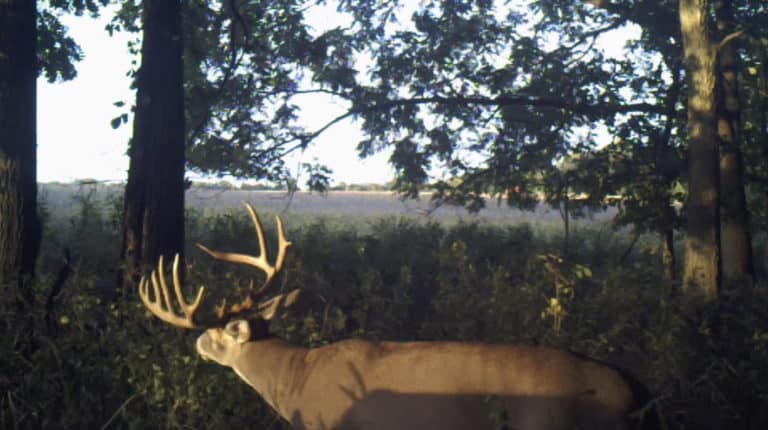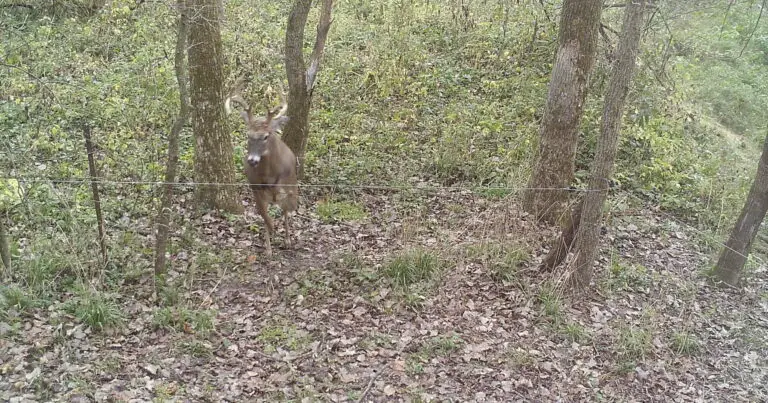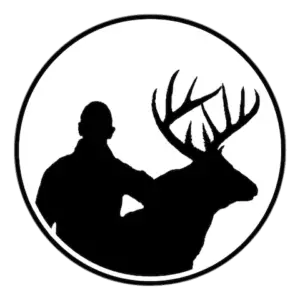As hunters, we spend many hours waiting for an opportunity to shoot a deer. It’s not very fun when our target deer finally arrives but doesn’t offer us a shot opportunity. Luckily for us, there are several strategies we can use to help us increase the odds of deer walking within bow range.
The most common methods for getting deer within bow range is by hunting pinch points and calling to them with buck grunts, doe bleats, or rattling antlers. Other attractions such as food plots, bait, mineral sites, water holes, and mock scrapes are also very popular strategies for achieving the same goal. Each of these tactics have pros and cons, so knowing how to use them strategically will help deer hunters be more successful at getting them within bow range.
Private land owners, or hunters with permission to manipulate the grounds where they hunt, have a huge advantage at getting deer within bow range. However, don’t be discouraged if you’re hunting ground that you can’t manipulate. Over half of the 21 strategies listed below can be utilized by any deer hunter, whether you own private land or not.
Read these two disclaimers prior to reading this rest of this article:
First, I almost never call to deer unless I see one and I’m confident that it won’t pass by within bow range on its own without me calling to it. In my experience rattling, grunting, bleating, and snort wheezing will likely scare deer away immediately or invite them to circle downwind of your location, where they will smell you and run away. Far too many hunters read an article like this and think they should be rattling or blind calling all the time. That can’t be further from the truth. If I had to put a number on it, I maybe only call to a deer 1 out of 5 hunts.
Second, attractions like mock scrapes, food plots, baiting stations, and water holes are excellent ways to get deer within bow range. However, each of these tactics will become less attractive if you have several of them scattered around the area. For example, I rather have all of my food in one or two locations because it will be easier to predict where the deer will be. If deer step into a food plot I want to have the best odds of seeing that deer. If there are 20 food plots scattered around, the odds of choosing the right food plot to hunt over is unlikely.

1. Mock scrapes
Deer are attracted to scrapes just like dogs are attracted to fire hydrants. Deer create scrapes and frequently revisit them in order to smell other deer that have used the scrape and re-mark their territory. Every mock scrape consists of a licking branch, vine, or rope that is suspended about 3-6’ off the ground. Additionally, scrapes have exposed dirt directly below the licking branch where deer paw at the ground and urinate.
2. Decoys
Decoys can be highly effective at getting deer to approach with bow range. I prefer using decoys when I don’t have any pinch points or other attractions to hunt over. Additionally, I will consider using a decoy when I think deer are more likely to pass along outside of shooting range.
If a buck is a few hundred yards away, consider snort wheezing to him to his attention. Once he sees the decoy, he may walk straight toward your position to check the decoy out. Plan on the buck approaching your decoy from the downwind side of it.
3. Rattling
Rattling deer antlers together seems to be more effective in some areas and not in others. Rattling seems to be effective when the buck to doe ratio is balanced and there is a good age structure amongst bucks.
I don’t recommend rattling in areas that have high hunting pressure. I also don’t suggest rattling if there aren’t any mature bucks in the area.
I only rattle as a last resort when I’m trying to get a buck to come back. The only other time I rattle is when my hunt is about over, I haven’t seen many deer during the hunt, and I don’t plan on hunting that location for 1-2 weeks or more. I usually rattle once or twice during the course of an entire deer season.
4. Buck grunting
Grunting is the call I use the most to draw a buck within bow range. However, I only grunt when I’m hunting near thick habitat or if I have a decoy set up. Grunting to a deer that can easily see through the woods will likely just alert them that they are being hunted.
I like my buck grunts to sound like a young buck. Young buck grunts are less threatening than a mature buck grunt. Not all big bucks want to fight, so it’s better for him to think the sound came from a young buck that he can easily beat in a fight. I recommend buying this call to achieve that young buck sound.
I rarely “blind-grunt” (grunting without seeing a deer) unless the hunt is about over, I haven’t seen many deer that day, and I don’t plan on hunting the location for 1-2 weeks or more.
5. Doe bleating
Doe bleating is effective for getting bucks within bow range during all phases of the rut. Bucks are obviously looking for estrus does during that time. If I’m hunting a buck that I believe to be non-aggressive around other bucks, I will use a doe bleat instead of a grunt. Some bucks will run away from a fight regardless of its age or antler size, so grunts are not always the best call to use on big bucks.
Doe bleats and fawn bleats can also be made with the same call that I suggested a few paragraphs back. This all-in-one call eliminates the need for taking multiple calls into the woods.
6. Fawn bleating -or- fawn distress call
Use a fawn bleat/distress call if you are trying to get a mature doe within bow range. The hope is that the does maternal instinct and curiously will get her to close the distance so you can shoot her.
7. Snort wheezing
Snort wheezing is a very effective calling method for aggressive and territorial bucks. Try snort wheezing at a buck if you can’t get a him to hear your grunt or doe bleat call. I make this call with my own mouth and it’s very easy to learn how to do it. You can snort wheeze as loud as you need to in order to stop that buck in his tracks and hopefully get him to come your direction.
8. Deer scents
There are several strategies for using deer scents to bring deer within bow range. One method is by attaching a scent wick to the licking branch of a scrape. Another is by dragging a scented rope through the woods on the way to a hunting location. The goal is that any deer crossing the scent trail, or traveling downwind of the scent, will smell it and decide to follow it within bow range.
I rarely use deer scent attractions. Actually, I stopped buying them after my first few years of hunting. I experimented with scents a lot during my early years of hunting and I learned that they aren’t worth the money. Can they work? Yes. However, they aren’t as effective as many companies and hunters lead you to believe. I believe the other strategies in this article are much more effective at getting deer to pass by within shooting range.
9. Hunt pinch points
Hunting deer in locations where they are naturally pinch down is arguably the best way to get them within bow range. There are several examples of pinch points created by Mother Nature, but we can also create pinch points of our own that encourage deer to move through an area at a specific location.
Look for topography features like saddles or transition areas that offer a path of least resistance for deer to travel from Point A to Point B. Pinch points also exist where rivers or lakes force deer to walk around them or cross at a specific location.

10. Hunt edges
It’s no secret that deer love edge habitat. There are lot of examples of edge habitat. For example, edge habitat could be a grassy field meeting up with the edge of woods. Another example is a thick patch of woods meeting up with an open patch of woods. Hunting these edges is a great way to get within bow range of deer because they tend to travel parallel with these edges.
11. Hunt open areas in the woods
Deer prefer to walk a path of least resistance. An open area in a thick path of woods is likely to be a great transition area for intercepting deer. Openings in the woods are also great places for scrapes and micro food plots to increase the attraction of that hunting location. All in all, open areas are great places for attracting deer within bow range.
12. Hunt staging areas
It can be difficult to identify where staging areas are. However, there is an excellent opportunity for getting deer to walk by within bow range if you can identify them. Staging areas can be found near destination feeding areas, like a food plot, orchard, or agriculture field. You might find a few rubs, a scrape, and deer beds in a staging area.
13. Cut down licking branches on scrape trees
Like I said at the beginning of this article, too much of a good thing can actually reduce your odds of deer passing by within bow range. I rather have one scrape, and not multiple scrapes, close to my hunting location.
If I’m hunting over a food plot with 3 or 4 scrape trees around the perimeter, I will cut down the licking branches on the scrapes that I don’t want deer to use. This will increase the attraction of the scrape that I want them to use.
14. Plant a scrape tree in an open area
Deer tend to gravitate towards stand-alone objects in an open area just like fish gravitate to structures under water. Therefore, planting a scrape tree in an open area is a great way to pull deer within bow range.

15. Water holes
Water holes are a great way to increase the attraction of a hunting location. Deer that have stayed within in their bedding area all day long might crave a drink of water. If a bedding area doesn’t have water within it, a waterhole can be a great attraction to hunt over in hopes that deer will stop by for a drink on their way to evening food sources.
Bucks will stop for a drink of water during the rut after they spend all day or night chasing and breeding does. Lastly, water is always a great attraction when warm weather is in the forecast and deer are trying to regulate their body temperatures in extreme heat.
16. Small food plots -or- micro plots
Micro plots are excellent for attracting deer within bow range. They can act as staging areas and transition zones for deer heading out to larger destination feeding areas.
The key to these food plots is they should be small enough so that any deer passing through them are highly likely to pass by within shooting range. If the landscape allows for it, I like long and narrow food plots about 25-30 yards wide.
17. Create a barrier
Some pinch points are too wide and allow deer to pass by outside of bow range. Also, some food plots may be too wide creating the same situation. Therefore, try creating a barrier to narrow the gap and force deer to cross in front of you within bow range. Barriers can be created several different ways. You can build a fence, cut some trees down, or pile up a bunch of brush into a pile that deer have to walk around.
18. Block off trails
Another way to increase deer traffic within bow range is by blocking off trails that are outside of bow range. If deer use multiple trails to get from point A to Point B, we can increase the odds of them walking down the trail we want them to by blocking the other trails. Cut some trees perpendicular to those other trails or install some fencing to encourage deer to walk down the trail we want them to.
19. Create trails
We can create trails where they don’t already exist to get deer to walk within shooting distance. For example, we can mow a trail or spray weed killer to create a path of least resistance.

20. Create fence gap
Fence gaps create a path of least resistance for deer to cross. This is a great method for creating a pinch point where one doesn’t exist. All we have to do is make one spot in the fence easier to cross than anywhere else along the fence. Deer will start using that crossing on a regular basis as long as it’s near an area where deer were already traveling previously.
21. Baiting and mineral sites
It’s no secret that baiting deer, and putting out minerals, is an extremely effective method for getting deer within bow range. That’s one of the many reasons why baiting is illegal in many states. If baiting is legal in your area, it’s a highly effective strategy for killing deer if it’s used strategically. If baiting is not used strategically it can result in deer only visiting these locations after dark.


